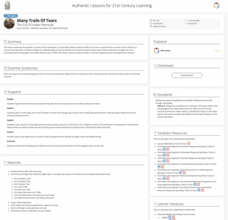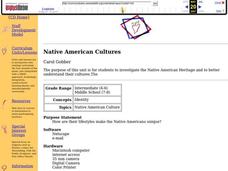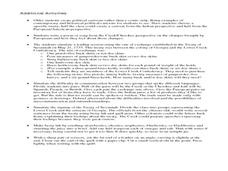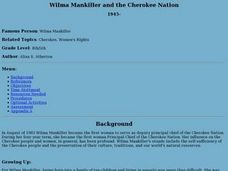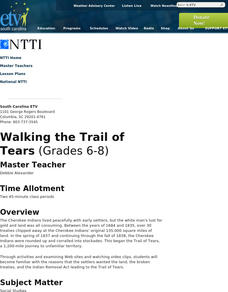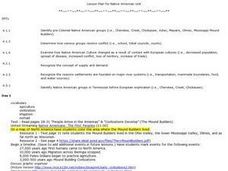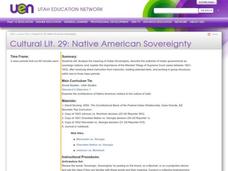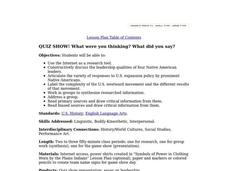K20 LEARN
Worcester v. Georgia: Cherokee Sovereignty and Actions of the U.S. Government
Young historians study the Supreme Court case "Worcester v. Georgia" and note instances where the Justices defended the sovereign rights of the Cherokee. They also examine the actions of President Andrew Jackson and the...
K20 LEARN
Many Trails of Tears: The Era of Indian Removal
Cherokee, Chickasaw, Choctaw, Creek, and Seminole. All were forced off their ancestral lands in the southeastern United States as part of the Indian Removal Act of 1830. Young historians research the tribes' reactions to this removal and...
Curated OER
Jacksonian America and the Indian Removal Act of 1830
Students utilize primary sources to explore the national climate concerning Native American Indians during the Andrew Jackson administration. They are presented with opinions for and against the Indian Removial Act of 1830 as they...
Curated OER
Native American Cultures
Students investigate the Native American Heritage and explore their customs cultures. They discover characteristics of the Native Americans through the study of their art, artifacts, stories and symbols.
Curated OER
Wattle and Daub Using Natural Resources to Survive
Seventh graders create list of materials that family of four would need to live and survive in the forest, identify four natural resources used by Cherokee Indians to build shelter, create poster that depicts Cherokee hamlet in summer or...
Curated OER
Native Lands: Indians in Georgia-Shifting Ground Political Cartoon-Introduction
Students explore the relationship between the Creek, Cherokee, and European/American cultures prior to the American Revolution. Students do Internet research to identify and explain changes in these cultures, then ...
Curated OER
Wilma Mankiller and the Cherokee Nation
Students examine how Wilma Mankiller became the first female Principal Chief of the Cherokee Nation. They listen to a teacher-led lecture, write a letter to President Andrew Jackson, participate in a jigsaw activity, conduct research,...
Curated OER
Walking the Trail of Tears
Middle schoolers, through the use of examining video clips and Websites, become familiar with the reasons that the settlers wanted the land, broke treaties, and initiated the Indian Removal Act leading to the Trail of Tears.
Curated OER
Creation Stories
Students read and research American Indian creation stories as a way to understand the origins of American Literature. They conduct Internet research utilizing Internet search engines. They create an online report page as well as write...
Museum of Tolerance
The Pursuit of Democracy and Diversity: The Trial of Pro-Social Injustice in Historical Documents and Accounts
Class members investigate The Indian Removal Act of 1830, U.S. Theft of Mexican Territory Timeline, and President Abraham Lincoln’s letter to Horace Greeley, 1862, and then conduct a mock trial of each of these documents to determine...
Alabama Learning Exchange
Would you fit in with the Cherokees?
Students use this activity as an introduction to the unit on Cherokee Native Americans. They discuss and research Cherokee dress and homes and identify difference between the Cherokee and the individuals in the class.
Race Briges Studio
I am Indopino: Or, How to Answer the Question, "Who Are You?"
In our increasingly multi-ethnic society, many students find it difficult to identify themselves as belonging to any one ethnicity. Gene Tagaban, a Tlingit, Cherokee, Filipino offers his personal experiences with these questions in his...
Curated OER
How the West was Lost-The Trail of Tears
In this Native American history worksheet, students respond to 14 short answer questions about Cherokee removal polices and the Trail of Tears.
Curated OER
Trail of Tears
Students discover that the Indian Territory was comprised of many Indian tribes originating from many different locations. They distinguish between the Indian tribes in the Indian Territory.
Alabama Department of Archives and History
Conflict in Alabama in the 1830s: Native Americans, Settlers, and Government
To better understand the Indian Removal Act of 1830, class members examine primary source documents including letters written by Alabama governors and the Cherokee chiefs. The instructional activity is part of a unit on the expansion of...
Curated OER
Craft Revival: Shaping Western North Carolina Past and Present
Students gain an understanding of a resident's lifestyle of North Carolina. They analyze five objects the are representation of the culture of North Carolina. Critical thinking skills are used to describe the geography through using the...
Curated OER
Native Lands: Indians in Georgia, How Do We Know What We Know?
Students examine Native American oral traditions. In this Georgia history lesson, students discuss Native American oral traditions and research stories of migration. Students create their own oral history projects that feature their...
Curated OER
Can You Make It? Using Natural Resources to Survive
Seventh graders describe the natural resources used to make the tools and weapons which best suited the needs of the Cherokee Indians. They will collect information regarding the making of a tool or weapon, and then explain to others...
Curated OER
Pre-Colonial Native American Groups
Students investigate U.S. history by researching the Internet and taking a test. In this American Indian group lesson, students identify the many specific Native American tribes and their geographic locations. Students research the web...
Curated OER
William Apess and the Mashpee "Revolt" of 1833
Prompt your class with the following question: What was the status of American Indians in Massachusetts during Jackson's presidency? To answer this question, class members will read a series of primary source documents (attached),...
Curated OER
Indians in Georgia: How Do We Know What We Know?
Students discover archaeology by investigating the history of Native Americans in Georgia. In this U.S. history lesson, students participate in a mock archaeological excavation in their classroom by recovering artifacts and...
Curated OER
Native American Sovereignty
Students analyze the meaning of Indian Sovereignty. They describe the authority of Indian governments as sovereign nations, and explain the importance of the Marshal Trilogy of Supreme Court cases between 1821-1832. They examine the...
Curated OER
Native American Bartering
Fifth graders create items to barter. In this Native American bartering lesson, 5th graders read a book, design and make items, and barter with their peers. Students reflect on the experience through journal writing.
Curated OER
QUIZ SHOW! What were you thinking? What did you say?
Students participate in a game show to share the information they have uncovered about the US expansion policy and how it affected Native Americans.

